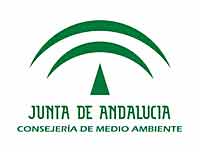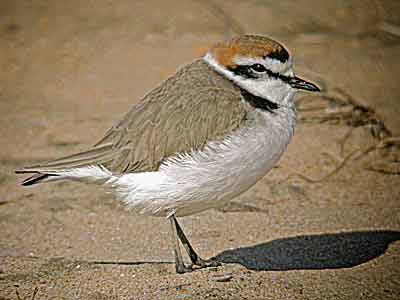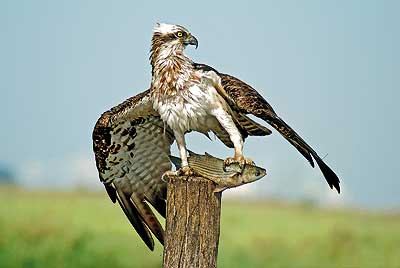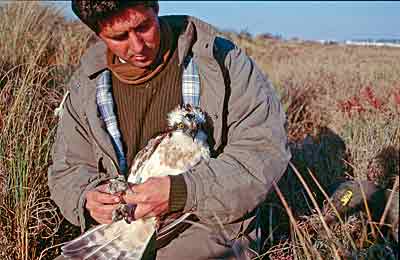| |

The Odiel Wetlands National Park is situated in the south-east of the Spanish peninsula, south of the Huelva province at the confluence of the Odiel and Tinto Rivers. It was declared a Biosphere National Reserve in 1983 with 7185 hectares of coastal marshland, of which 1100 hectares are saline, and 400 hectares of Mediterranean woodland.
The predominant vegetation in the wetland area is glassworts (Salicornia ramossisima) and Spartina grass (Spartina densiflora), salt resistant plants that create a flat landscape almost at water level. The most representative birds are the dunlin (Calidris alpina), curlew sandpiper (Calidris ferruginea) and Kentish plover (Charadrius alexandrinus). An infinite variety of other species also visit the park every year.

In this ornithological observation area the Consejeria de Medio Ambiente of the region of Andalusia implements monitoring projects to understand and conserve the avifauna and its habitat. Among the most important of these is the monitoring of bird populations such as the marsh harrier and the spoonbill, the reintroduction of the osprey as a nesting species and the monitoring of the wintering of the osprey and other migrating birds, especially the waders and Sternidae. There are two important tools used to study birds: scientific tagging and census. They are used to study the behaviour of the air-borne inhabitants, their number in a given area, their needs and shortages, their migratory routes, changes in migration, etc. To scientifically tag the birds they have to be caught; the bird must remain in contact with man for as little time as possible and be put under minimum stress. Once data such as sex, origin and destination and approximate age and physical condition have been collected, these birds are ringed. The rings are internationally regulated with a code unique to each bird and country of origin. The data is then inserted in the national register that allows the data to be compared should the bird be found again in a different part of the world. Each species has a different metal ring suitable for the size of the foot that causes no damage to the bird.

Monitoring and tagging of the wintering osprey population started in 1997 and was aimed at finding out the origin and destination of the specimens, the number of adult and young, male and female, their number in the area, etc. A harmless capture method was specifically created for this bird and one metallic and one coloured plastic ring with alphanumeric characters was placed on the leg for remote identification. In this way, beginning with a census at strategic points on the marshland area at different times of the day, 10 specimens were found, more than three times the estimated number, and it was discovered why the number was so low: a lack of natural roosting sites. The placing of wooden poles as roost sites has allowed the wintering population to increase rapidly. Today 80 specimens have been studied.
It was found that 75% are males and 25% females and that they use the same area and same roost site year after year. No new adults arrive, only young birds, which indicates that in their first year they take up a position in an area that they will return to throughout their lifetime.
Furthermore, it has been discovered that the adult birds do not share the roost, while the young do. However, regarding fishing they are not territorial; in fact 5 or 6 subjects can be seen fishing in the same area.
Thanks to the remote identification of these birds, we know that they come from Northern European countries (Finland, Norway, Sweden, Scotland and Germany), Sardinia and the Balearic Islands.  In the same year, 1997, monitoring and tagging of waders and Sternidae began in the post-mating period between July and October. The aim of this project is to determine the number of specimens of the species, the percentage of adults and young, and so estimate the results of the European breeding season, the origin, the wintering site, whether they use the same routes, which migrate first (young, adults, males, females), longevity, etc. A completely systematic method is used, placing the same number of nets, at the same sites, on similar dates and with similar natural light conditions, so that migration evolution can be evaluated from the data. The waders are small-sized species that feed on silt in the wetlands of the coastal and internal areas, thus the desiccation of these areas is deleterious to them. The wetland area of the Odiel is composed of coastal marshes, which means that there is water all year round and that it is an ideal resting and feeding spot for migrating birds. Each species has different characteristics, such as the beak or the foot, and for this reason each uses a different food compartment. For example the avocet, which has a curved beak, sweeps the surface of the mud, while other specimens with short beaks search for food at deeper or shallower levels.The Odiel is a feeding and resting site where the birds accumulate fat - the fuel needed to reach the African Continent - in the abdomen and breast. Their physical conditions and the time required to undertake the route south depend on it. The birds that visit this park every year are biological indicators of the quality of the habitat.
 Such an in depth study of these species had not existed until today, but through the tagging of more than 2000 birds, with more than 5% of the specimens recovered (compared to 0.2% of Passeriforms), we now know their migratory movements. It has been possible to prove that they use the same routes every year: south through the Straight of Gibraltar and over the Bosphorus or again Gibraltar on the return journey. Some species such as the arctic tern (which had never before been captured on the peninsula) and Bulwer’s petrel (that had never been seen before) have regular routes. Such an in depth study of these species had not existed until today, but through the tagging of more than 2000 birds, with more than 5% of the specimens recovered (compared to 0.2% of Passeriforms), we now know their migratory movements. It has been possible to prove that they use the same routes every year: south through the Straight of Gibraltar and over the Bosphorus or again Gibraltar on the return journey. Some species such as the arctic tern (which had never before been captured on the peninsula) and Bulwer’s petrel (that had never been seen before) have regular routes.
There is a network of volunteers that is crucial for the progress of the activities and an increase in environmental awareness. The Odiel Wetland, in addition to being a privileged observatory for ornithological study, is also a strategic migration area and thus an indispensable site for the very existence of these migratory birds.
 José Manuel Sayago Robles: José Manuel Sayago Robles:
creator of the project. The Andalusian ornithologist has proposed innovated methods to monitor and tag the wintering osprey population. |
|
